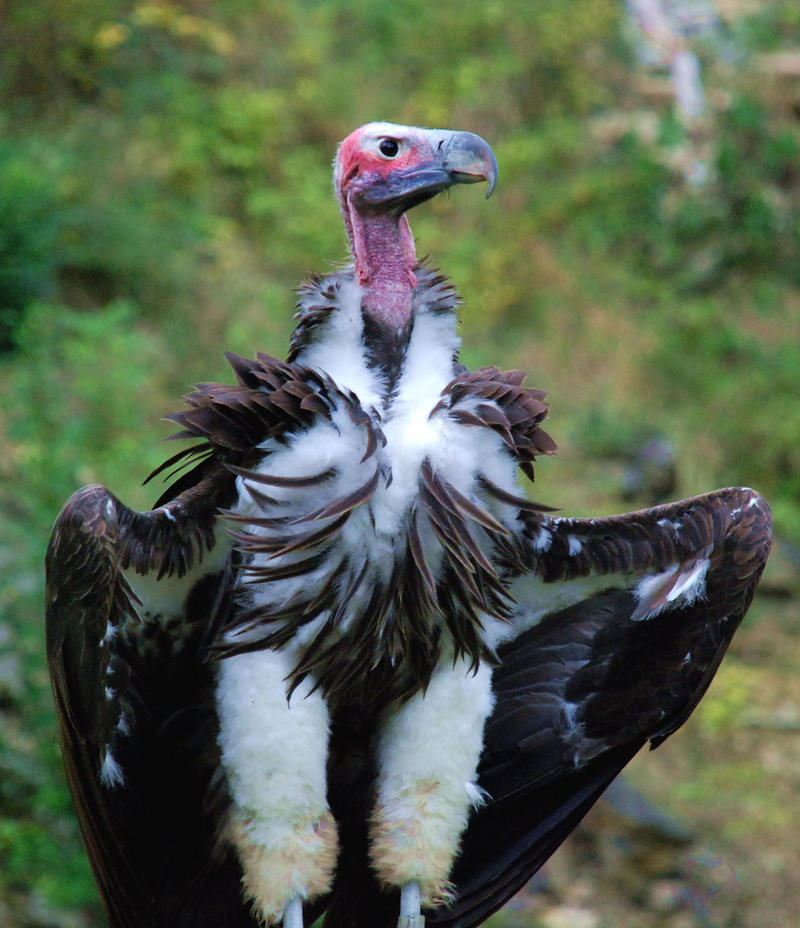|
| 질의: Mammal | 결과: 1558번째/3457 | |
Lappet-faced Vulture (Torgos tracheliotus) - Wiki
| 제목: | Lappet-faced Vulture (Torgos tracheliotus) - Wiki
| |

| 해상도: 1583x1837
파일크기: 373624 Bytes
등록시간: 2007:10:28 18:32:06
|
Lappet-faced Vulture
From Wikipedia, the free encyclopedia
[Photo] Lappet-faced Vulture (Torgos tracheliotus) in captivity in Wildpark Bad Mergentheim, Germany. Date 19. September 2007. Author Matthias Zepper
The Lappet-faced Vulture or Nubian Vulture, (Torgos tracheliotus) is an African Old World vulture belonging to the bird order Accipitriformes, which also includes eagles, kites, buzzards and hawks. It is the only member of the genus Torgos. A distinct subspecies T. t. negevensis occurs in the Sinai, the Negev desert and probably in north-west Saudi Arabia.
It is not closely related to the superficially similar New World vultures, and does not share that group's good sense of smell.
Like many vultures, it has a bald head. The pink (sometimes reddish) coloration is a distinctive feature. The head is bald because a feathered head would become spattered with blood and other fluids, and thus be difficult to keep clean.
It is a scavenging bird, feeding mostly from carcasses of dead animals which it finds by sight or by watching other vultures. Large carcasses, since they provide the most subsistence at a sitting, are preferred. Lappet-faced Vultures, perhaps more so than any other vulture, will also on occasion attack young and weak living animals and raid the nests of other birds. Locally, Lesser Flamingoes, among others, have been reported to be culled by Lappet-faces in this way.
It is about 1.15 meters (3.8 feet) long, with a wingspan of 2.5 meters (8.5 feet). The average weight is 6.7 kilograms (15 pounds). There are some records of birds as heavy as 15 kilogram (33 pounds), but these are believed to reference overfed, zoo-kept specimens. They are the most powerful and aggressive of the African vultures and other vultures usually cede a carcass to the Lappet-faced Vulture. This is often beneficial to the less-powerful vultures because the Lappet-face can tear through the tough hides and muscles of large mammals that the others can't penetrate, although hyaenas are even more efficient in this regard.
http://en.wikipedia.org/wiki/Lappet-faced_Vulture
| The text in this page is based on the copyrighted Wikipedia article shown in above URL. It is used under the GNU Free Documentation License. You may redistribute it, verbatim or modified, providing that you comply with the terms of the GFDL. |
|
댓글 |
|---|
| | 손님 |
|
I would love to use this photo - please can the poster make contact with me to discuss this possibility - thank you
derryn awesomesa@iafrica.com |
| | 손님 |
|
| The lappet-faced vulture or Nubian vulture (Torgos tracheliotos syn. Torgos tracheliotus) is an Old World vulture belonging to the bird order Accipitriformes. Torgos tracheliotos is patchily distributed through much of Africa, though it is absent from much of the central and western parts of the continent and declining elsewhere in its range. |
^o^
동물그림창고 똑똑전화 누리집
^o^
|
|
|